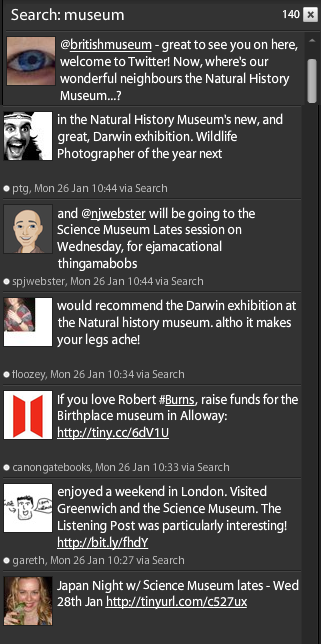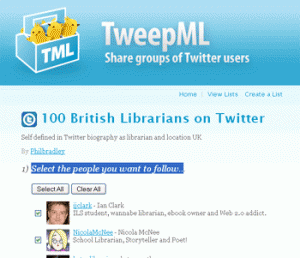What is your reaction to a new technology? Some people with tend to react positively, feeling that innovations can provide benefits; others, however, tend to be react dismissively to new technologies, arguing that they are irrelevant or counter-productive.
How do you tend to react to innovation, generally? And what are your views on the Twitter micro-blogging service? I suspect Twitter has provided a good example of how perspectives may be polarised along the lines I have suggested. Indeed a search for Twitter on the MCG JISCMail list reveals a series of interesting comments since the first reference in July 2007.
The discussion in July 2007 initially addressed the potential of Facebook for use in museums. Graham Turnbull (SCRAN) agreed with comments made by Mike Ellis (then at the Science Museum) which discussed some of the potential benefits which Facebook (which had just announced an opening up of the Facebook platform). And Graham went on to say that
All the evidence seems to point to activity within the rules of the medium being the attractor. For example, twitter [www.twitter.com] works if u want to regularly post one-liner updates
but is hopeless for a static description.
This seems to have been the first mention of Twitter on the list. And although Graham appeared to have been the first on the list to predict an interesting use case for Twitter it was Mike Ellis who, the following year, announced his Onetag Twitter aggregation tool for use at the Museums and the Web 2008 conference.
Around the same time Rhiannon Looseley sent a message about the new British Postal Museum & Archive (BPMA) Wiki in which she described that she is “particularly keen to find ways of making the most of Wikis’ potential for collaborative work“.
This message quickly led on to a lengthy discussion about the appropriateness of models like social networking and participative media to the delivery of museums online. But rather than repeat the discussions which took place (if you are interested in the details see the threads “British Postal Museum & Archive Wiki “, “suggestions that museums should use Twitter or Second Life … are ill-advised” and “Re: The speculative aspect of using Web 2 [was: British Postal Museum & Archive Wiki]” in the archives for July 2008)I would like to revisit the particular case of Twitter.
I think there is a tendency for innovation to be treated by some initially with scepticism as to whether the innovation is feasible and then, once tangible examples are demonstrated, by attempting to laugh at how it could be used. Here’s an example of this:
“Imagine a world in which Twitter did not exist (give it a couple of years…) would you really invent a constantly-updated trivia machine as the best way of communicating with museum audiences?“
Recently, however, we have seen a number of examples of Twitter becoming mainstream. A good example of this was the BBC News item on “Tweet smell of success over Digg” which described how “Use of Twitter, the mobile phone-based micro-blogging service, rocketed nearly 1,000% in the UK over the past year, according to industry analysts HitWise“.
 But what is the evidence suggesting about use of Twitter by museums? I recently created a search of Twitter posts (or ‘tweets’ as they are often called) for the term ‘museum’ in my Tweetdeck desktop Twitter client. And, as can be seen from the accompanying image, the Twitter community are using the service in a variety of ways:
But what is the evidence suggesting about use of Twitter by museums? I recently created a search of Twitter posts (or ‘tweets’ as they are often called) for the term ‘museum’ in my Tweetdeck desktop Twitter client. And, as can be seen from the accompanying image, the Twitter community are using the service in a variety of ways:
User feedback: A tweet by PTG described how this museum visitor was in the Natural History Museum’s new, and great, Darwin exhibition. Wildlife Photographer o f the year next“. Gareth described how he “enjoyed a weekend in London. Visited Greenwich and the Science Museum. The Listening Post was particularly interesting!“
Events: A tweet by spjwebster described how he “and @njwebster will be going to the Science Museum Lates session on Wednesday, for ejamacational thingamabobs“.
Promotional activities: A tweet by canongatebooks urged people to “if you love Robert #Burns, raise funds for the Birthplace museum in Alloway: http://tiny.cc/6dV1U“.
In addition to these examples I am very aware of how Twitter is being used to provide peer support, community-building and community discussions. Indeed suggests that Twitter has a role to play in marketing activities are sometimes met with concerns that this type of use will detract from the original role in played in community support such as, for example, the use of Twitter at conferences for museum professionals such as the Museums and the Web 2008 conference.
I’m not too concerned, myself, as I feel that the different uses can coexist. What we will need are mechnnisms for sharing examples of the different use cases and the associated best practices. UKOLN has published a number of IntroByte briefing documents, including three (so far) covering micro-blogging. We hope that these documents will prove useful to organisations which are thinking about making use of services such as Twitter.
I’d like to conclude with one specific example which illustrates the benefits I have gained from being able to tap into the expertise on my Twitter community. Catriona Cardie, Marketing Director, Our Dynamic Earth commented in a recent guest blog post:
“Personally I was astonished at the speed with which specialist could exchange information through a blogging network, and make this specialist knowledge widely available. This was clearly evidenced when Brian asked a question on his blog. Within seconds a really useful response, with further web references, had been returned.“.
I actually asked the question on Twitter and received a speedy response from Mike Ellis. It would be nice to thing that the huge growth in the popularity of Twitter was due to such examples. However I have to admit that I suspect that the growth in popularity is more likely to be due to articles on its use by celebrities such as Jonathon Ross and Stephen Fry. Not that I would be dismissive of such uses – after all celebrities also have Web sites too 




 But what is the evidence suggesting about use of Twitter by museums? I recently created a search of Twitter posts (or ‘tweets’ as they are often called) for the term ‘museum’ in my Tweetdeck desktop Twitter client. And, as can be seen from the
But what is the evidence suggesting about use of Twitter by museums? I recently created a search of Twitter posts (or ‘tweets’ as they are often called) for the term ‘museum’ in my Tweetdeck desktop Twitter client. And, as can be seen from the